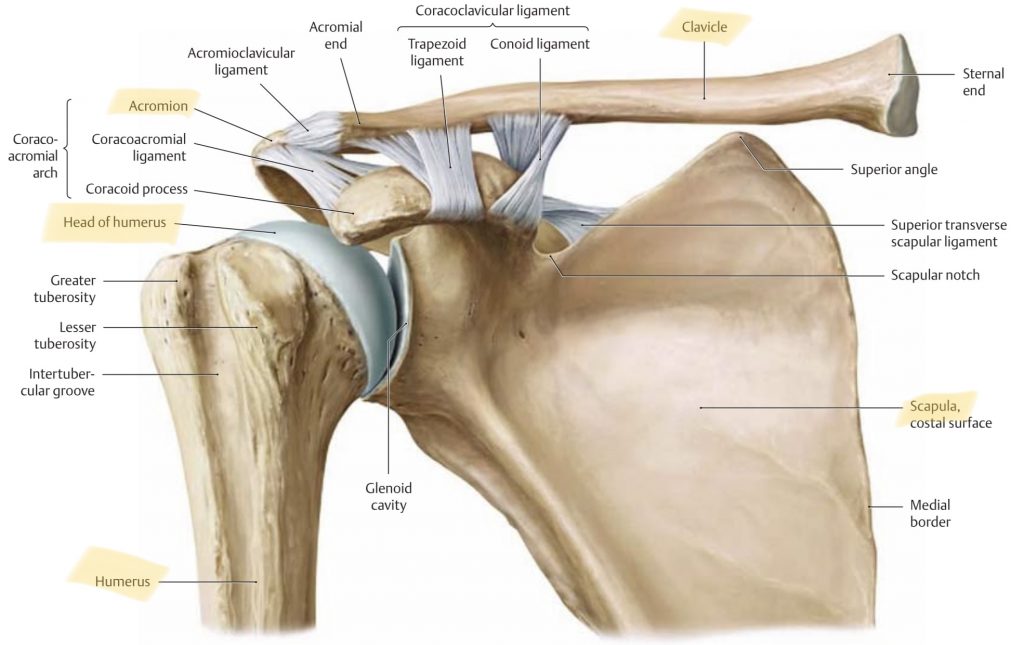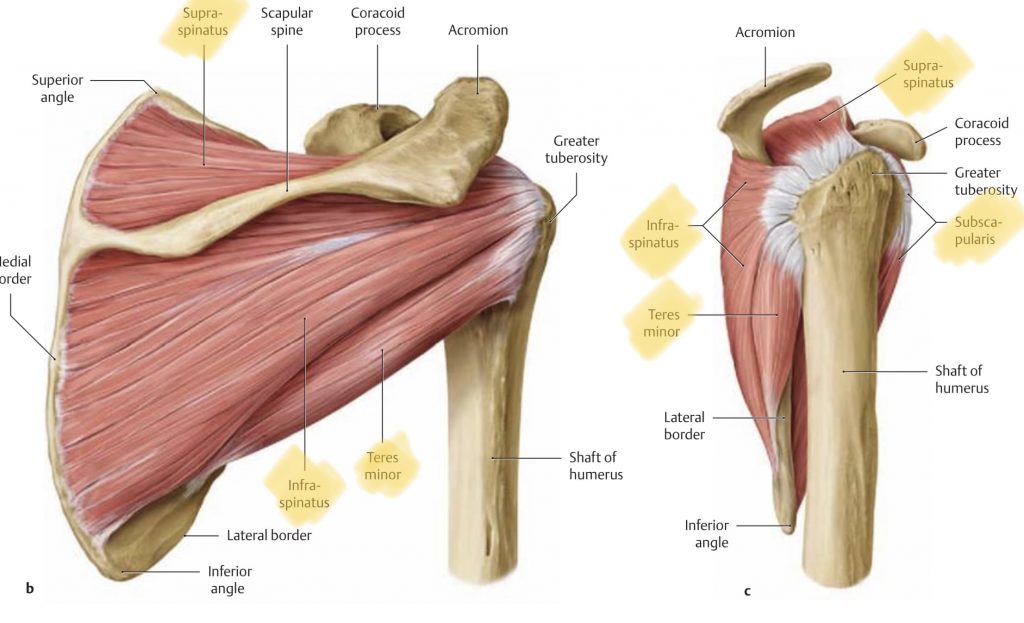How many repetitions you should do for your shoulder exercises depends on whether you train muscles or movements. And then, which muscles and/or which movements?
But before I explain the difference, I think it’s important to understand the anatomy of the shoulder. Because the shoulder is much more than what you see when you look down to your left and right.
1. Shoulder Girdle Anatomy
The shoulder girdle is made up of 3 bones, the scapula, the humerus, and the clavicula which connect through 4 joints. Of the 4 joints, the glenohumeral joint (GH Joint) is what is generally referred to as the shoulder. The other parts are the scapulothoracic joint (ST Joint) between your scapula and the thoracic spine, the acromioclavicular joint (AC Joint) between the roof of the scapula and the collarbone, and the sternoclavicular joint (SC Joint) between the collar bone and the breastbone.
You can never see consider? any of the joints of the shoulder girdle separately. At all times, they’re closely interrelated in their function.

This is essential because more joints allow for more movement freedom. Which in turn requires a large amount of active stability. This is stability provided by muscles that you control (actively) contrary to passive stability which comes from bones, joint capsules, labrum, ligaments, and connective tissue.
Now, let’s have a look at the muscles that control shoulder movement and their specializations. Because this will determine how many repetitions you should do for your shoulder exercises.
2. Which Muscles Belong to the Shoulder Girdle?
There are two main types of muscles making up the shoulder girdle, these are the global movers and the local stabilizers.
The global movers are good at moving your arm and scapula whereas the local stabilizers stabilize and thus centralize the humerus inside the glenoidal surface. The better the humerus maintains its position at the center of the glenoid, the more stable it is.
The global movers of the shoulder joint (with their main movement) are the:
- Deltoids (all parts, anteflexion, abduction, and horizontal abduction)
- Pectoralis major (horizontal adduction)
- Pectoralis minor (elevation of the scapula)
- Coracobrachialis (adduction)
- Biceps brachii (anteflexion)
- Triceps Brachii (retroflexion)
- Latissimus Dorsi (adduction)
- Teres Major (adduction)
- Trapezius (all parts, elevation, retraction, and depression of the scapula)
- Rhomboids (all parts, elevation, and retraction of the scapula)
- Levator Scapulae (elevation of the scapula)
- Serratus Anterior (which I consider both a stabilizer and a mover, makes a protraction of the scapula)
The local stabilizers are the:
- Subscapularis (internal rotation)
- Supraspinatus (abduction)
- Infraspinatus (external rotation)
- Teres minor (external rotation)
- And to some extent the serratus anterior (stabilization of the scapula on the rib cage)

Each of these muscles is equipped with the perfect muscle fibers to execute its jobs.
The global movers have a larger part of fast twitch muscle fibers and can thus generate more force and speed. Whereas the local stabilizers have a larger part of slow twitch muscle fibers which have a greater capacity to maintain tension over time.
So, here’s everything I discussed so far in 2 sentences:
- Global movers are muscles that move the joints of the shoulder girdle in all directions and consist mainly of fast-twitched muscle fibers that are good at generating force and speed.
- Local stabilizers are muscles that consist mainly of endurance slow twitch muscle fibers, that stabilize the joints of the shoulder girdle in its optimal position so the global movers can generate force efficiently.
3. How Many Repetitions Should You Do for Your Shoulder Exercises?
From an anatomical perspective, it’s now easy to answer how many repetitions you should do for your shoulder exercises.
Global movers are best trained with a lower number of repetitions and a higher amount of weight. Anything below 8 repetitions will do. The lower the number of repetitions the more you improve your maximum strength and the more you train the nervous system.
Local stabilizers are best trained with a high number of repetitions and lower resistance. I recommend anywhere between 15-30 repetitions with a weight with which you could do at least 3 more repetitions than your desired amount. This is a “3-repetition reserve”.
Nevertheless, rock climbing isn’t necessarily in line with your anatomy and might therefore require a different number of repetitions for your shoulder exercises.
So, another approach to knowing how many repetitions you should do for your shoulder exercises is by looking at rock climbing, analyzing the movements, and understanding what’s asked of your shoulder muscles.
Rock climbing exists of combined movements. So, it’s never only adduction, an internal rotation, and a horizontal abduction separately. It’ll be all these movements at the same time resulting in a pulling movement. Then for a gastone move, on the other hand, you need external rotation, horizontal abduction, abduction, and so on.
When you don’t train muscles but climbing movements the number of repetitions depends on what you want to accomplish:
- Endurance: 15-20 repetitions or more
- Hypertrophy 8-20 repetitions to failure
- Strength: 1-6 repetitions
- Speed: 1-10 repetitions with a focus on speed and acceleration and thus a lighter load (30-40% of your 1RM)
4. Important Take-Away’s
Both ways of approaching your shoulder exercises and the repetitions you use are valid forms of training. I think it’s best to combine both for optimal results. Training climbing movements help you to get stronger for specific movements whereas training muscles prevents you from developing imbalances and maintaining a healthy posture.
